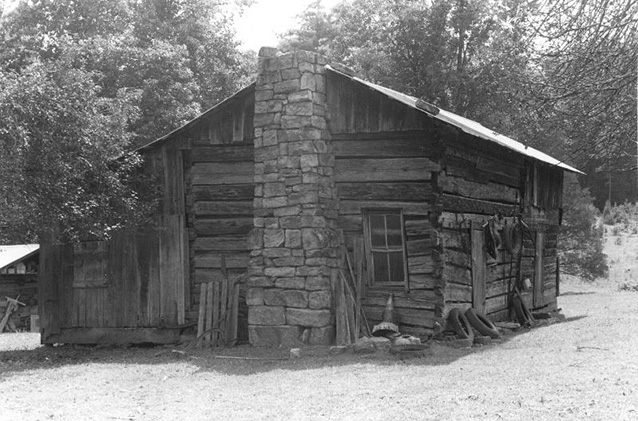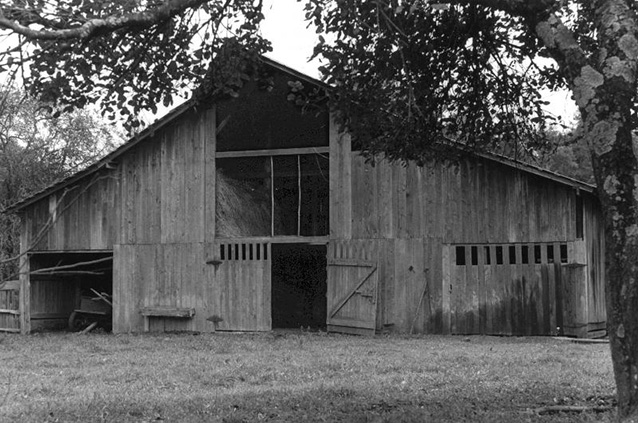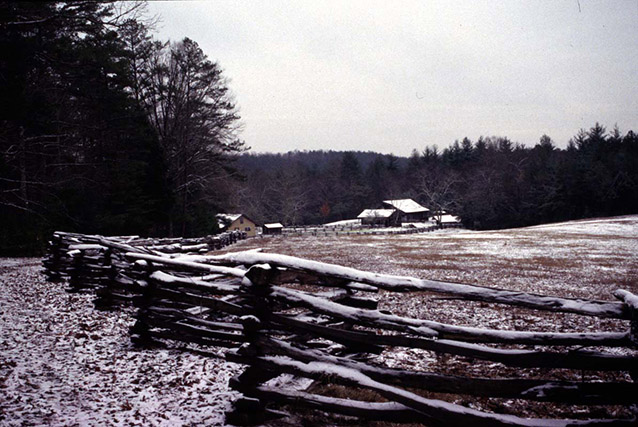The Oscar Blevins Farmstead is located on Old Leatherwood Ford Road in Fentress County, Tennessee. The landscape, nearly 24 acres, contains many features typical of a Cumberland Farmstead in the Big South Fork region. This includes fields and remnant orchards, an 1879 house, an outbuilding and corn crib both built circa 1870s-1880s, road traces, and remnant fence lines.

NPS
According to family tradition, the patriarch of the Blevins family, Jonathan Blevins (1779-1863), was born in present-day West Virginia and came through the Cumberland Gap to eventually settle in the Big South Fork region. In 1879, John "Jack" Blevins, great-grandson of Jonathan Blevins, built a story and a half, double-pen log home at this site.
A few changes were made to the site by Oscar Blevins, Jack Blevins's son, when he became owner of the property. In the 1950s, a wood frame house and outbuilding were built. The original log house was used as a barn during this time period, and a vertical plank addition was constructed on its south side. In the 1960s, a large wood frame barn was constructed. Oscar Blevins started a root cellar in the 1970s, though he stopped construction when he heard of the possibility of his land being included in the park area. Other features of the site included clearings for pasture and crops, an apple orchard, nut trees, fences and a spring. Big South Fork National River and Recreation Area was authorized by the Water Resources Development Act of 1974. The historically significant period continues until 1980, when Oscar Blevins and his family move from the property. The Oscar Blevins Farmstead is typical of the settlement patterns found throughout the Big South Fork plateau in the late 19th and early 20th centuries.
A number of historical landscape features still exist at the site, including fields, trees, road traces, and fence lines. Significant buildings at the site include an 1879 log house and a corn crib built about the same time. Additional buildings and landscape features at the site include a circa 1950s farmhouse, a circa 1950s outbuilding, a circa 1960s barn, and an uncompleted circa 1970s root cellar.
There are also contemporary structures and landscape features on the site including a circa 1950s farmhouse and barn, uncompleted root cellar, and fences.
The Oscar Blevins Farmstead is a part of the proposed Big South Fork Rural Historic District. The Historic District is significant at the state level for its association with the early settlement, agriculture and rural community life, and economy of the Upper Cumberland region in Tennessee. It also contains important examples of vernacular folk architecture once typical of the region, and it has potential to yield information important to understanding the historic human occupation of the area.

NPS
The diverse resources of the district are united historically and physically by their association with farming activity and rural life in the Upper Cumberland from 1821-1950. The district’s discontinuous pattern of historic rural landscapes separated by portions of undeveloped land vividly illustrates the intimate relationship that existed between the family farmers of the Upper Cumberland and the rugged terrain on which they lived.
The district is significant in the areas of agriculture, architecture, archaeology, community planning and development, exploration and settlement, and industry. The materials and workmanship of the District’s historic buildings and structures contribute to the overall integrity of the District. Adaptive reuse, stabilization, reconstruction, and repair efforts over the years have altered some of the buildings and structures, but they nonetheless retain the bulk of their original materials and exhibit the historic vernacular designs of their local builders and inhabitants.

NPS (Cultural Landscapes Inventory, 1998)
Due mostly to the Basin’s naturally confining physiography, a historic lack of any developed road system, and the existence of only narrow parcels of arable floodplain, the rural landscapes that developed here, as elsewhere in the Upper Cumberland, were unique in how they displayed the intimate relationship between land and people.
For the settlers and farmers of the district, the relative lack of fertile soil meant that agriculture was only one of many activities that helped to sustain their families and related kin. Other pursuits included hunting, fishing, lumbering, mining, ranching, bee keeping, moonshining and a host of folk practices and economies that have only recently disappeared from the area.
Quick Facts
- Cultural Landscape Type: Vernacular
- National Register Significance Level: State
- National Register Significance Criteria: A,C,D
- Period of Significance: 1879-1980
Landscape Links
Last updated: December 31, 2020
